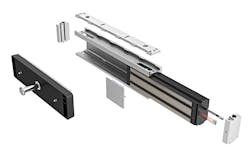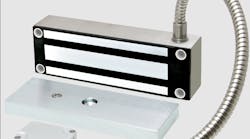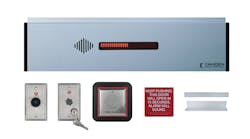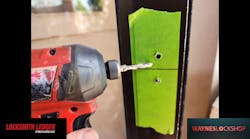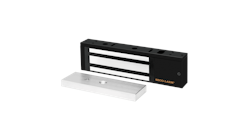The modern magnetic door lock was developed by Sumner “Irving” Saphirstein in 1969 to provide quick release of secured doors at the Montreal Forum, home of the Canadians hockey team. Saphirstein founded Locknetics, which now is an Allegion brand.
The magnetic lock, or maglock, became popular with burglar alarm and CCTV companies that were moving into the electronic access control business. The magnetic lock also is used widely by the professional lockshop and in many new-construction applications.
Touchless operation, so popular a topic these days, is often possible with a motion sensor, wave-to-exit buttons or any means to interrupt the power to the lock.
Previous Locksmith Ledger articles are well worth reviewing. Tim O’Leary’s April 2018 article on “Electromagnetic Locks for Safety and Security” and Jerry Levine’s July 2015 discussion of magnetic locks provide good background. Allegion code expert Lori Greene reviews must-read code issues in the March 2019 article, “Electromagnetic Locks-7 Applications and Codes That Apply.” An excellent video, “Decoded: Code Requirements for Electromagnetic Locks,” on Greene’s website, idighardware.com, illustrates important information as of 2018.
The Basics
The essential components of a magnetic lock are the electromagnet and the armature (strike), which are attracted when 12- or 24-volt power is applied. (Some devices have a built-in rectifier and filter, allowing direct connection to 12 or 24 VAC power.)
Coils of wire wrapped around a ferromagnetic core, such as iron, can produce a strong magnetic attraction that firmly holds an armature (strike) plate attached to a door, gate or cabinet.
Magnetic locks are coated to prevent the ferrous metal from rusting. In outdoor applications, some oxidization or debris might form on the surface. A light cleaning with an abrasive nonmetallic scouring pad can remove accumulated oxide to maintain a firm bond between the magnet and armature. Steel wool products should be avoided, because they leave traces of steel behind that exacerbate the oxidization process. After extensive use, the lock’s coating might be scrubbed or worn off, requiring periodic buffing with the nonmetallic scouring pad to maintain a clean surface. Corrosive or salty atmospheres will require more-frequent attention.
The primary differences among manufacturers’ products might include current draw, metallurgy, winding details and holding force. Other differences can be in mounting-bracket designs, internally or externally connected options, special sizes and shapes. Options can include delayed egress, weatherized treatment, gate or double-door applications, built-in request-to-exit sensor, CCTV camera, remote-release infrared receiver, door-position and tamper switches, bond sensor, door-forced sensor, relock delay, status LEDs, hazardous atmosphere protection and early-warning door attack sensors.
Distribution channels tend to follow industry norms through regional and national lock, burglar alarm, CCTV and integrator wholesalers. Allegion focuses its Schlage brands on contract-hardware markets, while its Locknetics brand focuses on all other markets. ASSA ABLOY’s Securitron and Alarm Controls brands plus dormakaba’s RCI brand are available through all of the above channels. Other brands generally are available through typical wholesale sources. Wholesalers will have links, and you also can search manufacturers’ websites.
Know the Code
Greene explains several code issues that pertain to magnetic locks by the International Builders Code (IBC) and the National Fire Protection Association (NFPA) in two applications: when the lock is released by a sensor or by door-mounted hardware.
With respect to release by a sensor, IBC and NFPA require unlocking also in the following cases:
- Loss of power to the sensor.
- Loss of power to the lock or locking system.
- Activation of a building’s fire-alarm or sprinkler system.
In addition, the door must include a manual unlocking device that’s 40–48 inches above the floor, within 5 feet of the door and marked “Push to Exit.”
As for magnetic locks released by door-mounted hardware:
- The hardware must have an obvious method of operation and be operated readily with one hand under all lighting conditions.
- Operation must directly interrupt power to the lock, and the door must unlock immediately.
- The door also must unlock upon loss of power to the locking system.
- If panic hardware were required, operation of that hardware must release the lock.
There is one concern regarding an electrified lock released by door-mounted hardware. Total dependence on the door hardware switch creates a single-point failure opportunity. I’ve seen contacts welded together, particularly when a magnetic lock is wired improperly. A secondary timed wall-mount exit button might be a prudent investment.
Some control boards use an input to activate a relay, releasing the magnet. Our own technicians preferred to have the secondary release button directly interrupt the power, as is now required for sensor-release applications. Of course, the contacts have to be rated adequately.
You might encounter other issues. Magnetic lock standards are defined under ANSI/BHMA Section A156.23. Also, a recent update of UL 1034 defines holding-force standards as well as power-supply requirements and associated tests. Because magnetic locks are inherently fail-safe, reliability of the power supply for a security application in a wide range of conditions becomes an important issue. Greene notes that access control systems that include magnetic locks might have to comply with the UL 294 standard, which largely deals with system reliability.
If any of those standards were contained in a specification, verify that the hardware that you plan to use actually meets the standard. In some cases, a standard might be specified to establish a level of performance; in others, to limit competition. Experience recommends finding out what the customer really wants.
Ready for Use
Applications typically focused on traffic control, security, delayed egress, sequence locks and mantraps (controlled vestibules), swing or sliding gates, rollup doors and cabinets. We’ve seen jewelry stores install mantraps after approval by the Authority Having Jurisdiction (AHJ) or delayed-egress systems to inhibit grab-and-run robberies. Air locks to clean rooms, labs or other such uses are excellent applications as well. Delayed egress is found frequently in patient-retention systems at memory-care and rehab facilities. Hazmat magnetic locks from RCI, SDC and Securitron are applied in areas where volatile materials are stored.
A pistol range I attend has a pair of sliding sound-containment doors controlled by an interlock circuit board and magnetic locks. Cabinets and drawers sometimes use smaller magnets in the 80–300-pound range.
Some creative applications occur. An industrial trash compactor company uses magnetic locks to secure containers before operation. In another case, storage containers holding large bulls are secured with light-duty magnetic locks. Because these animals might panic, the locks are sized to allow being forced open to prevent harm to the animals.
At a large test laboratory, we once installed extensive magnetic lockdown hardware to defend against attacks. It paid off shortly after installation when an attack was thwarted. We also configured interlocks to allow traffic only in one direction with entry to the clean side and exit from the contaminated side.
Interlocks are a popular application. Be sure to review any interlock application with the AHJ, because they likely are to be covered in the proposed “Controlled Vestibules” section of the 2021 IBC model code, along with mantraps. Be aware that local adoption might take years.
A few possible operations:
Normally unlocked or air lock control – Typically a low-security system used for environmental control, allowing two or more doors to be opened simultaneously.
Secure entry / free egress – A more secure system that allows rapid egress through a combination of locked and unlocked doors.
Restricted entry and exit –A high-security system for when all doors typically are locked.
Rule 1: Check with the AHJ as to which version of IBC is adopted and what will be approved. Some jurisdictions still might not approve magnetic locks on exit doors. Rule 2: Don’t forget Rule 1.
Grand Designs
Basic designs of magnetic locks include direct-pull, shear style and Securiton’s unique device that has a secondary clamping mandible that provides 4,000 pounds of holding force when the door is attacked. Direct-pull magnetic locks range from BEA and Seco-Larm’s mini-magnet cabinet locks that have 80 pounds of holding force up to 1,650-pound models. One Rofu shear model is rated at 2,200 pounds.
Shear locks have an interesting physical characteristic. Magnets withstand considerable direct-pull force, but they can slide to one side or another rather easily. The shear lock armature (strike plate), which is mounted on the door, has a button that fits into a dimple in the electromagnet. Although the magnet is in shear and could slide off easily, the armature has to pull directly away to allow the button(s) out of the dimple. This action requires a lot of direct-pull force — in fact, several hundred additional pounds.
Double-swing doors sometimes use shear locks; however, caveats exist. Double-swing doors are subject to wind or static pressure and have a tendency to rest in different positions as conditions vary. Although shear locks might capture a door moving past center, this isn’t considered reliable and can lead to less positive or even no engagement. The consensus recommends against using shear locks on most double-swing doors. A popular solution is to convert the doors to out-swing only, using direct-pull magnetic locks or stops.
Warping is a common issue as users attempt to open doors held by top-mounted magnets. Dortronics and Rofu developed magnetic locks that have the armature in the pull handle. This eliminates door wracking as well as reduced holding force from misalignment.
Voltage spikes and delayed release were concerns with early magnetic locks. When power was switched off, the magnetic field would collapse, releasing a rather large voltage spike called counter electromotive force (C-EMF), which often damaged or destroyed relay contacts and circuit boards. In typical electronic applications, a diode between the positive and negative leads short-circuits the C-EMF.
However, cycling the current back through the lock causes a problem for magnetic locks, because it delays the lock’s release. The solution is to install a metal oxide varistor (MOV) that’s rated slightly above the input voltage to clamp the C-EMF voltage spike. Correct polarity is critical. Higher rated MOVs, however, won’t produce the desired protection. Magnetic locks produced in recent years generally have the MOV already installed. Check your installation instructions to verify the necessity.
Cameron Sharpe, CPP, worked 30 years in the commercial lock and electronic access industry. Contact him at [email protected]
